
Mold spores can spread fast in your home. They can grow everywhere: on your clothes, carpet, food, and in places that you cannot see. Molds can grow in pipes, inside your walls, and above the ceiling tiles.
Mold problem is not only costly but is also hard to fix. Molds produce irritants and allergens that can affect your health. If you want to reduce the mold growing in your home, below are tips you can follow.
Dry Wet Places Fast
Mold grows fast when there is moisture. It is ideal to tackle wet areas very fast to discourage any dampness. Moistness can happen due to heavy rainfall, spillages, or leaks within one to two days. In case of floods, remove anything that cannot dry from your home.
Avoid leaving wet things lying around. Ensure your floors and walls are dry. Mold can also spread fast if you have wet clothes in your washing machine. Hang them where there is good air circulation.
Ventilate Your Home
Your routine indoor activities could encourage mold growth. Ensure simple activities like cooking do not cause mold growth. Properly ventilate the areas in your house that are prone to high moisture.
Vent devices that produce moistness to the outside of the house. Run an exhaust fan or open a window when cooking or showering. Do so to avoid holding enough moistness to breed the growth of molds.
Correct Problem Areas in Your Home
You can make your home resistant to molds by identifying problem areas and working on them. Audit your house to find out what areas need investigating. Look for areas prone to flooding or water leakages to repair the damages. The process can be costly, but it is worth it eventually. Have the gutters on your roof cleaned and examined to check if they have any damage.
Repair them and be keen to check for water stains in case of leakages. Indoor plants tend to attract mold due to the moisture in their soil. If this happens, make a point of ridding your home of any plants that attract moistness that can endanger your health.
Use Mold-Resistant Products
Mold-resistant products are essential for areas in your home prone to wetness. You may need such products in your kitchen, laundry area, bathroom, or basement.
Traditional walls have gypsum plaster pressed between paper plies. Mold-resistant walls have no paper and have a gypsum core covered by fiberglass.
Traditional walls are susceptible to mustiness, and it can be difficult to rid them of any mold. Successful removal and replacement of the wall can be expensive. There are also mold-resistant gypsum boards.
Track the Humidity in Your Home
Use a moisture meter to measure the humidity in your home. You can buy one from your local hardware. Paying attention to the potential areas that pose a threat in your home can help detect high humidity.
Condensation on walls, windows, and pipes is a sign of excessive humidity. It is crucial to dry surfaces that have condensation and address the cause of the moisture. Catching risk factors can help you mitigate health risks. Ensure your home is always habitable and dry.
For more about reducing molds in your home, visit Prime Property Group at our offices in Oakland and Sacramento, California. You can also call (510) 225-0470 or (916) 822-9655 to book an appointment today. For emergencies, you can call (510) 645-5070.





